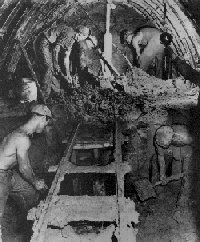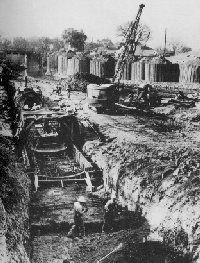
Courier-Journal and Louisville Times Photo
Drainage
Drainage became an ever-more-complex problem in the 1950s, due partly to the policies of the past and partly to the tight finances of the present.
One result was that MSD stopped building combined storm and sanitary sewer lines in the mid-1950s. At first, the decision was economic: sanitary-only sewer lines cost much less than combined sewers, and could be financed by the fees and rates paid by the property owners being served. The Louisville Times opposed the policy, asking in a 1956 editorial: "Why Not Do a Complete Job of Sewering?"
It was becoming evident, however, that combining stormwater and wastewater created difficult problems throughout the system. Untreated sewage was dumped into the streams when heavy rains overloaded the sewer lines, and partly treated wastewater had to be dumped into the streams and the river when heavy rains overloaded the treatment plants. These problems would become a major focus of clean-water efforts in the 1980s and 1990s.
The City of Louisville, which had given MSD its old combined sanitary and storm sewer system, would contend for decades to come that MSD was responsible for drainage in the city; MSD would counter that its only income, from sanitary sewer fees, had to go for much-needed sanitary sewer improvements. A separate drainage fee or drainage property tax in the city was discussed in the early 1950s, but city government wouldn’t allow it. Because of the lack of adequate financing, stormwater drainage work was limited in the city.
Jefferson County government, however, acknowledged that it was responsible for drainage outside city limits. Drainage problems increased tremendously as farms became suburbs. In the mid-1950s, the county contracted with MSD to manage its drainage program; the county agreed to pay all the costs.

The First Rate Increase
MSD’s first rates remained in effect, without substantial change, for nearly a decade. A good part of the reason was the ongoing debate with city government over financing the treatment plant and extending sanitary sewers throughout the city. Costs kept rising as the debate continued.
Finally, an agreement was reached, and in mid-1956 MSD eliminated its 33 1/3 percent discount for prompt payment of bills. For most customers, who paid their bills on time, this amounted to a 50 percent rate increase. But more than two-fifths of this money went to make up for inflation, which had been significant. In the nine years since the first rates were established, the cost of living had increased more than 21 percent.
MSD History continued - The Challenges Increase


